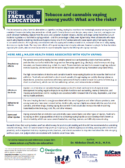Tobacco and cannabis vaping among youth: What are the risks?
Download the Fact Sheet! (447.53 kB / pdf)
DownloadFirst introduced as a less harmful alternative to cigarette smoking, vaping has now become increasingly popular among youth for a variety of reasons including low perceptions of risk, youth-friendly flavours and designs, easy access, low cost, and aggressive youth-directed marketing. Results from the 2018-2019 Canadian Student Tobacco, Alcohol and Drugs Survey found that 34% of students in grades 7-12 had tried a vaping product. – and this percentage is likely even higher today. Most adolescents who vape report using liquids containing nicotine and approximately one-third of adolescents who vape report using their vaping device to consume cannabis. Although only some students who try vaping will develop an addiction, many will move on to using vaping devices on a regular basis. The long-term effects of frequent vaping remain largely unknown, however vaping is far from harmless – especially for youth, who are more vulnerable to experiencing the negative health impacts vaping can have.
HERE ARE 5 MAJOR HEALTH RISKS ASSOCIATED WITH YOUTH VAPING:
RESPIRATORY EFFECTS
The aerosol produced by vaping devices contains several toxic and potentially toxic chemicals and fine particles that can be harmful to the lungs such as flavouring agents (e.g. diacetyl), volatile compounds (e.g. benzene), and heavy metals (e.g. nickel, tin, lead). These chemicals can lead to increased coughing, reduced exercise capacity, and increased risk for severe lung disease such as Vaping-Associated Lung Injury (VALI).
ADDICTION
The high concentrations of nicotine and cannabis found in many vaping liquids can increase the likelihood of addiction. Youth who are addicted to nicotine and cannabis through vaping can quickly develop tolerance, dependence, as well as experience withdrawal symptoms if they’re unable to vape for a period of time (e.g. as short as a few hours), which can interfere with sleep, school, and extracurricular activities.
EFFECTS ON THE BRAIN
Regular use of nicotine or cannabis through vaping can lead to short and long-term changes in brain development including negative impacts on key brain functions such as learning, memory formation, and impulse and emotional control. Vaping is also associated with increased risk of anxiety, depression, and other mental health problems.
BEHAVIOURAL EFFECTS
The use of vaping devices is strongly associated with the use of cigarettes and other tobacco products, even among teens who have never smoked before. Additionally, vaping is highly associated with the use of alcohol, cannabis, and other drugs. Sharing vaping devices with friends could also increase the risk of catching transmissible infections (e.g. cold, flu, and other viruses).
BURNS AND OTHER INJURIES
Vaping products that are defective can potentially cause severe burns and other types of injuries. Youth who try vaping or drink large quantities of nicotine-containing vaping liquids can also develop what’s known as nicotine toxicity, which can cause severe headaches, vomiting, tremors, and difficulty concentrating.
Research shows that vaping devices aren’t an effective way for youth to quit smoking and shouldn’t be recommended as a smoking cessation strategy. There are several ways to help youth quit vaping (e.g. individual/group counselling, speaking with a healthcare provider), and an important first step requires parents, teachers, and school counselors to stay informed about the risks of vaping and have open, non-judgemental conversations with students about these risks.
ADDITIONAL INFORMATION RESOURCES
Talking with your teen about vaping (Caring for Kids by Canadian Paediatric Society)
About Vaping (Government of Canada)
Youth and Vaping (Drug Free Kids Canada)
References
Chadi, N., Minato, C., & Stanwick, R. (2020). Cannabis vaping: Understanding the health risks of a rapidly emerging trend. Paediatrics & Child Health, 25. doi: 10.1093/pch/pxaa016. Retrieved from: https://academic.oup.com/pch/article/25/Supplement_1/S16/5857591
Chadi N., Hadland, S., & Harris, S.K.(2019). Understanding the implications of the “vaping epidemic” among youth.Substance Abuse Journal. Retrieved from: https://www.tandfonline.com/doi/abs/10.1080/08897077.2019.1580241?journalCode=wsub20
Chadi, N., Schroeder, R., Jensen, J.W., & Levy, S. (2019). Association Between Electronic Cigarette Use and Marijuana Use Among Adolescents and Young Adults: A Systematic Review and Meta-analysis. JAMA Pediatrics. Retrieved from: https://jamanetwork.com/journals/jamapediatrics/article-abstract/2748383
Chadi N, Bélanger RB. (2019). Teen vaping: There is no vapour without fire, Paediatrics & Child Health. Retrieved from: https://academic.oup.com/pch/article-abstract/doi/10.1093/pch/pxz137/5601210
Chadi N, Camenga DR, Harris, SK and colleagues. (2020). Protecting Youth From the Risks of E-Cigarettes: a Position statement from the Society for Adolescent Health and Medicine, Journal of Adolescent Health. Retrieved from: https://www.sciencedirect.com/science/article/pii/S1054139X19305063?via%3Dihub

